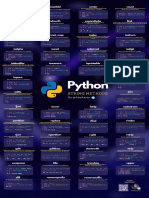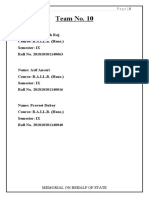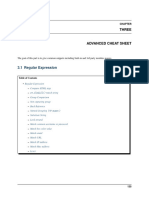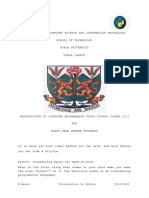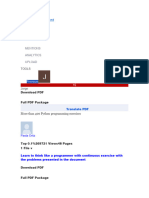Basics Cheat Sheet Python For Data Science: Strings Lists
Uploaded by
Char SiewBasics Cheat Sheet Python For Data Science: Strings Lists
Uploaded by
Char Siew> Strings > Lists Also see NumPy Arrays
Python For Data Science >>> my_string = 'thisStringIsAwesome'
>>> my_string
>>>
>>>
a = 'is'
b = 'nice'
Basics Cheat Sheet
'thisStringIsAwesome' >>> my_list = ['my', 'list', a, b]
>>> my_list2 = [[4,5,6,7], [3,4,5,6]]
String Operations
Selecting List Elements Index starts at 0
Learn Python Basics online at www.DataCamp.com >>> my_string * 2
'thisStringIsAwesomethisStringIsAwesome'
Subset
>>> my_string + 'Innit'
'thisStringIsAwesomeInnit'
>>> my_list[1]
#Select item at index 1
>>> 'm' in my_string
>>> my_list[-3] #Select 3rd last item
True Slice
> Variables and Data Types String Indexing Index starts at 0
>>>
>>>
>>>
my_list[1:3] #Select items at index 1 and 2
my_list[1:] #Select items after index 0
my_list[:3] #Select items before index 3
>>> my_list[:] #Copy my_list
Variable Assignment >>> my_string[3]
>>> my_string[4:9] Subset Lists of Lists
>>> my_list2[1][0] #my_list[list][itemOfList]
>>> x=5
>>> my_list2[1][:2]
>>> x
5
String Methods
>>> my_string.upper()
#String to uppercase
List Operations
Calculations With Variables >>>
>>>
my_string.lower()
#String to lowercase
my_string.count('w') #Count String elements
>>> my_list + my_list
>>> my_string.replace('e', 'i') #Replace String elements
['my', 'list', 'is', 'nice', 'my', 'list', 'is', 'nice']
>>> x+2 #Sum of two variables
>>> my_string.strip() #Strip whitespaces >>> my_list * 2
['my', 'list', 'is', 'nice', 'my', 'list', 'is', 'nice']
>>> x-2 #Subtraction of two variables
>>> my_list2 > 4
True
>>> x*2 #Multiplication of two variables
10
>>> x**2 #Exponentiation of a variable
25
> NumPy Arrays Also see Lists
List Methods
>>> x%2 #Remainder of a variable
>>> my_list = [1, 2, 3, 4]
1
>>> my_list.index(a) #Get the index of an item
>>> my_array = np.array(my_list)
>>> x/float(2) #Division of a variable
>>> my_list.count(a) #Count an item
>>> my_2darray = np.array([[1,2,3],[4,5,6]])
2.5 >>> my_list.append('!') #Append an item at a time
>>> my_list.remove('!') #Remove an item
Types and Type Conversion Selecting Numpy Array Elements Index starts at 0 >>>
>>>
del(my_list[0:1])
#Remove an item
my_list.reverse() #Reverse the list
>>> my_list.extend('!') #Append an item
Subset >>> my_list.pop(-1) #Remove an item
str()
>>> my_list.insert(0,'!')
#Insert an item
'5', '3.45', 'True' #Variables to strings >>> my_array[1] #Select item at index 1
>>> my_list.sort() #Sort the list
2
int()
Slice
5, 3, 1 #Variables to integers
>>> my_array[0:2]
#Select items at index 0 and 1
float()
5.0, 1.0 #Variables to floats
array([1, 2])
Subset 2D Numpy arrays
> Python IDEs (Integrated Development Environment)
bool() >>> my_2darray[:,0] #my_2darray[rows, columns]
array([1, 4])
True, True, True #Variables to booleans
Leading open data science
Free IDE that is included
Create and share
Numpy Array Operations platform powered by Python with Anaconda documents with live code
> Libraries >>> my_array > 3
> Asking For Help
array([False, False, False, True], dtype=bool)
>>> my_array * 2
array([2, 4, 6, 8])
>>> my_array + np.array([5, 6, 7, 8])
Data analysis Scientific computing 2D plotting Machine learning array([6, 8, 10, 12]) >>> help(str)
Import Libraries Numpy Array Functions
>>> import numpy
>>> my_array.shape #Get the dimensions of the array
>>> import numpy as np >>> np.append(other_array) #Append items to an array
>>> np.insert(my_array, 1, 5) #Insert items in an array
>>> np.delete(my_array,[1]) #Delete items in an array
Selective import >>>
>>>
np.mean(my_array) #Mean of the array
np.median(my_array) #Median of the array
>>> my_array.corrcoef() #Correlation coefficient
>>> from math import pi >>> np.std(my_array) #Standard deviation
Learn Data Skills Online at
www.DataCamp.com
You might also like
- Dan Stefanica, Radoš Radoičić, Tai-Ho Wang - 150 Most Frequently Asked Questions on Quant Interviews, Third Edition (Pocket Book Guides for Quant Interviews)-FE Press, LLC (2024)No ratings yetDan Stefanica, Radoš Radoičić, Tai-Ho Wang - 150 Most Frequently Asked Questions on Quant Interviews, Third Edition (Pocket Book Guides for Quant Interviews)-FE Press, LLC (2024)280 pages
- 12 Comp Sci 1 Revision Notes Pythan Advanced ProgNo ratings yet12 Comp Sci 1 Revision Notes Pythan Advanced Prog5 pages
- 8 Best Python Cheat Sheets For Beginners and Intermediate Learners100% (1)8 Best Python Cheat Sheets For Beginners and Intermediate Learners17 pages
- 201 Python Programming Exercises For AllNo ratings yet201 Python Programming Exercises For All425 pages
- Python 3 Beginner's Reference Cheat Sheet: by Via100% (1)Python 3 Beginner's Reference Cheat Sheet: by Via1 page
- 200+ Python Exercises For Beginners Solve Coding ChallengesNo ratings yet200+ Python Exercises For Beginners Solve Coding Challenges8 pages
- Basics of Python For Data Machine LearningNo ratings yetBasics of Python For Data Machine Learning32 pages
- Data Structures and Algorithms (DSA) in Python - Self PacedNo ratings yetData Structures and Algorithms (DSA) in Python - Self Paced4 pages
- Python - 3 Books in 1 - Beginner's Guide, Data Science and Machine Learning. The Easiest Guide To Start Python Programming. Unlock Your Programmer Potential and Develop Your Project in100% (1)Python - 3 Books in 1 - Beginner's Guide, Data Science and Machine Learning. The Easiest Guide To Start Python Programming. Unlock Your Programmer Potential and Develop Your Project in241 pages
- Introduction To Computer Programming Using Python Comp 111No ratings yetIntroduction To Computer Programming Using Python Comp 111227 pages
- Python Programming 4th Edition Singh A. all chapter instant download100% (4)Python Programming 4th Edition Singh A. all chapter instant download72 pages
- Python For Data Science Cheat Sheet: Subset Slice50% (2)Python For Data Science Cheat Sheet: Subset Slice1 page
- Machine Learning Algorithm, Second Edition by Giuseppe BonaccorsoNo ratings yetMachine Learning Algorithm, Second Edition by Giuseppe Bonaccorso1 page
- Becominghuman - Ai-Cheat Sheets For AI Neural Networks Machine Learning Deep Learning Amp BignbspData100% (1)Becominghuman - Ai-Cheat Sheets For AI Neural Networks Machine Learning Deep Learning Amp BignbspData24 pages
- Python Basics to Advanced by Sardar Azeem (1)No ratings yetPython Basics to Advanced by Sardar Azeem (1)122 pages
- A Practical Time-Series Tutorial With MATLABNo ratings yetA Practical Time-Series Tutorial With MATLAB95 pages
- 7 Time Series Datasets For Machine LearningNo ratings yet7 Time Series Datasets For Machine Learning8 pages
- The Python Workbook: A Brief Introduction with Exercises and Solutions 2nd Edition Ben Stephenson all chapter instant download100% (1)The Python Workbook: A Brief Introduction with Exercises and Solutions 2nd Edition Ben Stephenson all chapter instant download49 pages
- NLTK: The Natural Language Toolkit: Steven Bird Edward LoperNo ratings yetNLTK: The Natural Language Toolkit: Steven Bird Edward Loper4 pages
- Augmented Renal Clearance and How To AugmentNo ratings yetAugmented Renal Clearance and How To Augment12 pages
- Kiit World School, Gurgaon LESSON PLAN (Social Science) DATE: 5-08-19 Class: 5No ratings yetKiit World School, Gurgaon LESSON PLAN (Social Science) DATE: 5-08-19 Class: 56 pages
- 15 Ways To Make Social Studies InterestingNo ratings yet15 Ways To Make Social Studies Interesting2 pages
- United States v. Shaquila Bumpass, 4th Cir. (2014)No ratings yetUnited States v. Shaquila Bumpass, 4th Cir. (2014)3 pages
- Teacher: Stan Gabriela School:No.7 Petroşani Grade: 3 Course: Way Ahead 1No ratings yetTeacher: Stan Gabriela School:No.7 Petroşani Grade: 3 Course: Way Ahead 15 pages
- Pnoc-Energy Development Corporation:: Case AnalysisNo ratings yetPnoc-Energy Development Corporation:: Case Analysis22 pages
- Qualification and Disqualification of An Advocate To Be Enrolled As An Advocate Under The Advocates ActNo ratings yetQualification and Disqualification of An Advocate To Be Enrolled As An Advocate Under The Advocates Act8 pages
- Chapter Seven: Causal Research Design: ExperimentationNo ratings yetChapter Seven: Causal Research Design: Experimentation30 pages
- English Mastering .... Useful Web Sites.........No ratings yetEnglish Mastering .... Useful Web Sites.........8 pages


